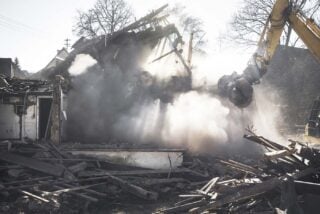
Asbestos use is not banned in most of the world. However, in countries with an asbestos ban in place, removal of past uses is ongoing and continues to expose workers to the mineral. For example, asbestos use was banned in Poland in 1997. Today, the country focuses on asbestos removal efforts. Government-owned asbestos plants processed more than 80% of all asbestos used in Poland. The plants primarily manufactured chrysotile asbestos cement, which is a focus of removal efforts today.
A Polish study analyzed potential asbestos exposure when workers remove asbestos. Researchers found when workers removed asbestos cement sheets, the concentration of asbestos fibers in the air commonly exceeds legal limits. Researchers analyzed 153 air samples taken during the asbestos removal process. They discovered that in 93% of workspaces studied, asbestos concentrations were at dangerous levels. Employees repeatedly working in these conditions are at an increased risk of developing asbestos-related diseases.
Removal of Asbestos Products Continues to Expose Workers
Asbestos was used worldwide in construction because of its durability and heat- and fire-resistant capabilities. As such, asbestos removal continues to be a top priority for old buildings, homes and schools. Removal by professionals is critical to help prevent and limit exposures. However, air samples collected at asbestos removal jobsites at residential buildings and industrial cooling towers indicated dangerous concentrations of asbestos fibers.
In a 2019 retrospective study, researchers analyzed data collected from 2000 to 2005. Researchers studied 76 air samples from residential buildings undergoing removal of asbestos cement sheets. This data was compared to another 77 air samples collected at industrial cooling towers undergoing similar asbestos cement removal.
The asbestos cement sheets in the residential spaces appeared to be in better condition prior to removal, with no damage visible to the naked eye. However, these sheets were attached to wooden scaffolds with wooden planks that did show heavy damage.
The asbestos cement sheets in the cooling towers appeared corroded and damaged from being continuously washed with hot water. Researchers noted the corroded cement sheets from the cooling towers cracked upon removal.
Previous research suggests damaged asbestos products, such as the sheets in the cooling tower, can lead to higher concentrations of released fibers in the air. However, the study found workers at the residential facility were exposed to higher concentrations of asbestos fibers than those removing the damaged sheets in the cooling towers.
Analysis of Air Samples at the Jobsites
When analyzing the air samples, researchers found the airborne asbestos fibers collected at both jobsites were short and thin.
The asbestos cement at the residential facility contained:
- 10 – 12% chrysotile asbestos
The asbestos cement sheets at the industrial cooling towers contained two types of asbestos fibers. The cooling tower asbestos cement was composed of:
- 10% chrysotile asbestos
- 3% crocidolite asbestos
Chrysotile asbestos is the most common type of asbestos used in developed countries. Studies have found between 90 – 95% of all asbestos present in buildings today is comprised of these asbestos fibers.
Crocidolite asbestos is rarer than chrysotile fibers, but is considered the most dangerous type of asbestos because it is more brittle and easily breaks apart. Because crocidolite fibers become airborne easily, those handling the removal of the material, as well as those working nearby, are at an increased risk of exposure.
The air samples taken at these worksites revealed asbestos exposure among workers at various stages of the project. Job duties varied between the residential and industrial asbestos removal; however, at both asbestos jobsites, those removing the materials from the structure and those transporting the asbestos waste were exposed to asbestos fibers exceeding legal limits.
Analysis of the air samples concluded that 93% of the workspace air samples exceeded legal exposure limits. The ambient air at the residential jobsites contained the chrysotile fibers. Samples of ambient air at the cooling towers contained crocidolite, chrysotile and amosite asbestos fibers. The presence of fibers within the ambient air may have exposed any workers in the area, including those not directly involved with the removal process.
Researchers found workers directly removing the asbestos cement from the structures were exposed to marginally higher concentrations of asbestos fibers. At the residential facility specifically, workers stripping the asbestos cement panels generated the highest level of airborne asbestos fibers. According to the samples collected, the highest concentration of fibers found was 0.90 f/cm3 (density). The current legal Polish asbestos concentration within dust is 0.1 f/cm3.
Workers transporting materials still experienced dangerous exposure levels, as shown in ambient air samples. Those transporting the asbestos cement sheets at the same facilities were exposed to 0.84 f/cm3.
Long Work Hours Increase Risk of Asbestos Diseases
While there’s no safe level of asbestos exposure, studies have found the risk of developing an asbestos-related disease increases with extended and recurrent exposure to the mineral.
According to the Polish study, employees at both jobsites worked shifts longer than 8 hours. Oftentimes, employees worked up to 80 hours each week. This extended exposure has been found to increase the risk of death due to an asbestos-related disease, such as mesothelioma.
These recent findings support a British study from 2008. Researchers found workers spending more than 40 hours per week on asbestos removal had an increased incidence of asbestos-related cancers than their counterparts working fewer than 10 hours per week.
Other factors can also increase the risk of an asbestos disease, including:
- Heat stress
- Heavy smoking
- Physical fatigue
- Poor diet
The study also found that no asbestos removal method (e.g., wet method) was successful in decreasing asbestos-related disease mortality rates among workers. Lung cancer, mesothelioma and circulatory disease were found to be the most common causes of death found among the more than 30,000 asbestos removal workers studied.
The findings from these studies reiterate the importance of following all asbestos protocols, including limiting work hours when in hazardous conditions.




